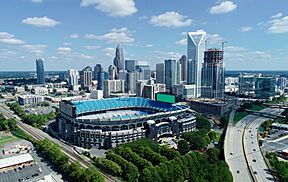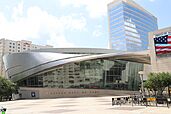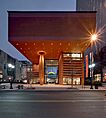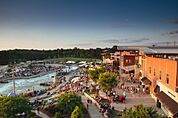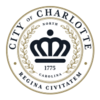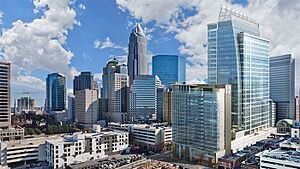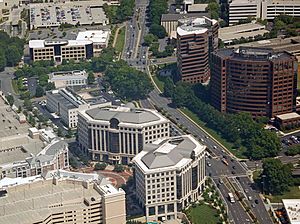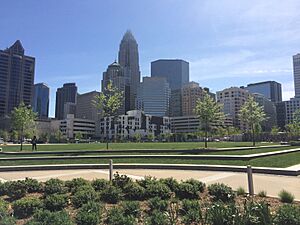Charlotte, North Carolina facts for kids
Quick facts for kids
Charlotte
|
|||||
|---|---|---|---|---|---|
|
|||||
| Nicknames:
The Queen City, The QC, CLT, The Hornet's Nest
|
|||||
| Motto(s): | |||||
| Country | United States | ||||
| State | North Carolina | ||||
| County | Mecklenburg | ||||
| Settled | 1755 | ||||
| Incorporated | December 3, 1768 | ||||
| Named for | Charlotte of Mecklenburg-Strelitz | ||||
| Government | |||||
| • Type | Council–manager | ||||
| • Body | Charlotte City Council | ||||
| Area | |||||
| • Total | 312.00 sq mi (808.08 km2) | ||||
| • Land | 310.02 sq mi (802.94 km2) | ||||
| • Water | 1.98 sq mi (5.14 km2) 0.63% | ||||
| Elevation | 673 ft (205 m) | ||||
| Population
(2020)
|
|||||
| • Total | 874,579 | ||||
| • Estimate
(2023)
|
911,311 | ||||
| • Rank | 40th in North America 15th in the United States 1st in North Carolina |
||||
| • Density | 2,821.06/sq mi (1,089.22/km2) | ||||
| • Urban | 1,379,873 (US: 37th) | ||||
| • Urban density | 2,098.3/sq mi (810.2/km2) | ||||
| • Metro | 2,805,115 (US: 22nd) | ||||
| Demonym(s) | Charlottean | ||||
| GDP | |||||
| • Charlotte (MSA) | $228.9 billion (2022) | ||||
| Time zone | UTC−5 (EST) | ||||
| • Summer (DST) | UTC−4 (EDT) | ||||
| ZIP Codes |
282XX
|
||||
| Area codes | 704, 980 | ||||
| FIPS code | 37-12000 | ||||
| GNIS feature ID | 2404032 | ||||
Charlotte (![]() i/ˈʃɑːrlət/ SHAR-lət) is the largest city in North Carolina, a state in the United States. It's also the main city of Mecklenburg County. In 2020, about 874,579 people lived here, making it the 15th biggest city in the U.S.
i/ˈʃɑːrlət/ SHAR-lət) is the largest city in North Carolina, a state in the United States. It's also the main city of Mecklenburg County. In 2020, about 874,579 people lived here, making it the 15th biggest city in the U.S.
Charlotte is a major center for culture, money, and travel in its wider area. This area, called the Charlotte metropolitan area, had about 2.8 million people in 2023. Between 2004 and 2014, Charlotte was one of the fastest-growing cities in the country. People who live in Charlotte are called "Charlotteans".
Charlotte is home to big companies like Bank of America and Honeywell. It's also a huge banking center, second only to New York City.
The city has many fun places to visit. You can cheer for three professional sports teams: the Carolina Panthers (football), the Charlotte Hornets (basketball), and Charlotte FC (soccer). Other cool spots include the NASCAR Hall of Fame, Mint Museum, Bechtler Museum of Modern Art, Billy Graham Library, Carowinds amusement park, and the U.S. National Whitewater Center.
Charlotte has a warm, wet climate. It's close to the Catawba River and Lake Norman, which is the biggest human-made lake in North Carolina. The city is also very green, with 66% of its area covered by green spaces. It's even ranked as one of the greenest cities in the world!
Contents
- Charlotte's Story: How It Grew
- Charlotte's Location and Look
- Who Lives in Charlotte?
- Charlotte's Economy: A City of Business
- Fun Things to Do in Charlotte
- Sports in Charlotte
- Learning in Charlotte
- Charlotte's Media Scene
- Getting Around Charlotte
- Famous People from Charlotte
- Charlotte's Sister Cities
- See also
Charlotte's Story: How It Grew
Early Days and Names
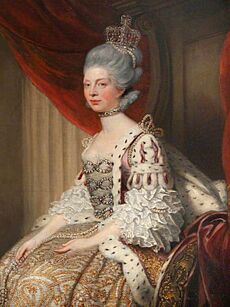
The first people known to live in the Charlotte area were the Catawba Indians. They were first written about in Spanish records around 1567. Sadly, many Catawba people died from diseases like smallpox after Europeans arrived.
In the 1700s, settlers from Scotland and Ireland, mostly Presbyterians, came to the area. German immigrants also settled here. The city of Charlotte was first settled by European colonists around 1755.
Charlotte got its nickname, the "Queen City," in honor of Charlotte of Mecklenburg-Strelitz. She became the queen of Great Britain and Ireland in 1761, just seven years before the town officially became a city.
Another nickname, "The Hornet's Nest," came from the American Revolutionary War. A British general named Charles Cornwallis, 1st Marquess Cornwallis was driven out of the city by angry residents. He said Charlotte was "a hornet's nest of rebellion."
The town officially became Charlotte in 1768. In 1770, streets were planned in a grid shape. The main crossroads, where Native American trading paths met, became the heart of Uptown Charlotte. One path became Trade Street, and the other became Tryon Street. Today, this intersection is called "Trade and Tryon" or "The Square."
In 1775, local leaders signed the Mecklenburg Resolves. This was an early step towards America's independence from British rule. May 20, the day it was signed, is still celebrated in Charlotte.
Gold Rush and Growth
In 1799, a 12-year-old boy named Conrad Reed found a 17-pound rock near Charlotte. Three years later, it was discovered to be almost solid gold! This started America's first gold rush. Many gold veins were found, leading to the creation of the Charlotte Mint in 1837. North Carolina was the top gold producer in the U.S. for a while.
The Reed Gold Mine operated until 1912. The Charlotte Mint closed during the American Civil War. The building now houses the Mint Museum of Art.
After the Civil War, Charlotte grew quickly. It became a center for processing cotton and a major railroad hub. By the 1880s, Charlotte was on the main railway line from Atlanta to Washington, D.C. Farmers brought cotton to the city, and textile factories began to open.
Charlotte's population kept growing. By 1910, it was North Carolina's largest city. It grew even more during World War I when a large army camp, Camp Greene, was set up nearby.
Modern Charlotte: Banking and Beyond
In the 1970s and 1980s, Charlotte became a huge banking center. A leader named Hugh McColl helped turn a local bank into Bank of America, one of the biggest banks in the U.S. Another bank, First Union (later Wachovia), also grew a lot. This made Charlotte the second-largest banking city in the United States, after New York City.
Charlotte has faced some big storms. In 1989, Hurricane Hugo hit the city, causing a lot of damage and knocking out power. In 2002, a severe ice storm also caused widespread power outages.
Charlotte's Location and Look
Where Charlotte Is Located
Charlotte covers about 312 square miles. It's mostly in Mecklenburg County in the Piedmont area of North Carolina. Uptown Charlotte sits on a hill between two creeks.
Even though the Catawba River and its lakes are a few miles west, there aren't any big bodies of water right in the city center. This has helped Charlotte grow as a major hub for highways, trains, and air travel.
Cool Neighborhoods to Explore
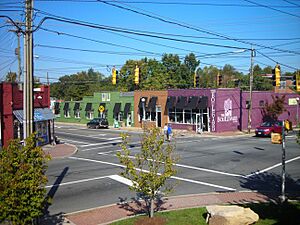
Charlotte has almost 200 neighborhoods that spread out from Uptown.
- Biddleville, west of Uptown, is a historic African American community.
- Plaza-Midwood, east of Uptown, is known for its many different cultures.
- The North Tryon and Sugar Creek areas have several Asian American communities.
- NoDa (North Davidson), north of Uptown, is a lively area for arts and fun.
- Myers Park, Dilworth, and Eastover have some of Charlotte's oldest and largest homes.
- The SouthPark area is great for shopping and dining.
- University City in the northeast is home to UNC Charlotte.
- Ballantyne in the south has grown very fast with new homes and businesses.
Since the 1980s, Uptown Charlotte has seen a lot of new buildings, including skyscrapers for big companies, hotels, and apartments.
Parks and Green Spaces
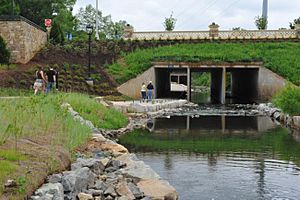
Charlotte has many parks and green spaces for everyone to enjoy.
- Latta Park was an amusement park back in 1891.
- Bryant Park was created in the 1930s.
- The 120-acre Park Road Park has basketball courts, baseball fields, picnic areas, playgrounds, and an 11-acre lake.
- Romare Bearden Park, a 5.4-acre park, opened in 2013 in Uptown.
- The Little Sugar Creek Greenway is a walking and biking path that runs through the city.
- McAlpine Creek Park was the first greenway built in this part of North Carolina in 1978.
The city has also bought homes in areas that flood often. This has created about 200 acres of open land that can safely flood, saving money and helping with safety.
Charlotte's Weather
Charlotte has four clear seasons. Winters are short and mild, with temperatures sometimes dropping below freezing. Summers are hot and humid, with many days reaching 90°F or higher.
It rains pretty evenly throughout the year, with August being a bit wetter. Charlotte gets about 3.5 inches of snow each year, mostly in January and February. Snow and ice storms can cause problems, like knocking out power.
| Climate data for Charlotte, North Carolina (Charlotte Douglas Int'l), 1991–2020 normals, extremes 1878–present | |||||||||||||
|---|---|---|---|---|---|---|---|---|---|---|---|---|---|
| Month | Jan | Feb | Mar | Apr | May | Jun | Jul | Aug | Sep | Oct | Nov | Dec | Year |
| Record high °F (°C) | 79 (26) |
82 (28) |
91 (33) |
96 (36) |
98 (37) |
104 (40) |
104 (40) |
104 (40) |
104 (40) |
99 (37) |
85 (29) |
80 (27) |
104 (40) |
| Mean maximum °F (°C) | 70.6 (21.4) |
73.6 (23.1) |
81.6 (27.6) |
85.9 (29.9) |
90.4 (32.4) |
94.7 (34.8) |
97.0 (36.1) |
96.1 (35.6) |
92.0 (33.3) |
85.6 (29.8) |
77.8 (25.4) |
71.2 (21.8) |
98.0 (36.7) |
| Mean daily maximum °F (°C) | 52.3 (11.3) |
56.6 (13.7) |
64.2 (17.9) |
73.2 (22.9) |
80.1 (26.7) |
86.9 (30.5) |
90.3 (32.4) |
88.6 (31.4) |
82.8 (28.2) |
73.3 (22.9) |
62.9 (17.2) |
54.9 (12.7) |
72.2 (22.3) |
| Daily mean °F (°C) | 42.1 (5.6) |
45.7 (7.6) |
52.7 (11.5) |
61.1 (16.2) |
69.0 (20.6) |
76.6 (24.8) |
80.1 (26.7) |
78.6 (25.9) |
72.7 (22.6) |
61.9 (16.6) |
51.4 (10.8) |
44.7 (7.1) |
61.4 (16.3) |
| Mean daily minimum °F (°C) | 31.8 (−0.1) |
34.9 (1.6) |
41.2 (5.1) |
49.1 (9.5) |
58.0 (14.4) |
66.2 (19.0) |
69.9 (21.1) |
68.7 (20.4) |
62.6 (17.0) |
50.4 (10.2) |
39.8 (4.3) |
34.5 (1.4) |
50.6 (10.3) |
| Mean minimum °F (°C) | 14.8 (−9.6) |
19.3 (−7.1) |
23.7 (−4.6) |
32.9 (0.5) |
43.3 (6.3) |
55.5 (13.1) |
62.2 (16.8) |
60.0 (15.6) |
49.8 (9.9) |
33.9 (1.1) |
23.8 (−4.6) |
19.6 (−6.9) |
12.6 (−10.8) |
| Record low °F (°C) | −5 (−21) |
−5 (−21) |
4 (−16) |
21 (−6) |
32 (0) |
45 (7) |
53 (12) |
50 (10) |
38 (3) |
24 (−4) |
11 (−12) |
−5 (−21) |
−5 (−21) |
| Average precipitation inches (mm) | 3.49 (89) |
3.13 (80) |
3.95 (100) |
3.84 (98) |
3.36 (85) |
3.99 (101) |
3.74 (95) |
4.35 (110) |
3.71 (94) |
3.16 (80) |
3.31 (84) |
3.57 (91) |
43.60 (1,107) |
| Average snowfall inches (cm) | 1.6 (4.1) |
1.1 (2.8) |
0.3 (0.76) |
0.0 (0.0) |
0.0 (0.0) |
0.0 (0.0) |
0.0 (0.0) |
0.0 (0.0) |
0.0 (0.0) |
0.0 (0.0) |
0.1 (0.25) |
0.4 (1.0) |
3.5 (8.9) |
| Average precipitation days (≥ 0.01 in) | 10.3 | 9.7 | 10.2 | 9.0 | 9.5 | 10.6 | 10.5 | 10.1 | 7.7 | 7.1 | 8.1 | 9.6 | 112.4 |
| Average snowy days (≥ 0.1 in) | 0.9 | 0.5 | 0.2 | 0.0 | 0.0 | 0.0 | 0.0 | 0.0 | 0.0 | 0.0 | 0.0 | 0.3 | 1.9 |
| Average relative humidity (%) | 65.7 | 61.8 | 61.5 | 59.3 | 66.9 | 69.6 | 72.2 | 73.5 | 73.3 | 69.9 | 67.6 | 67.3 | 67.4 |
| Average dew point °F (°C) | 27.3 (−2.6) |
28.6 (−1.9) |
36.3 (2.4) |
43.5 (6.4) |
54.9 (12.7) |
63.0 (17.2) |
67.1 (19.5) |
66.7 (19.3) |
61.2 (16.2) |
49.5 (9.7) |
39.6 (4.2) |
31.3 (−0.4) |
47.4 (8.6) |
| Mean monthly sunshine hours | 173.3 | 180.3 | 234.8 | 269.6 | 292.1 | 289.2 | 290.0 | 272.9 | 241.4 | 230.5 | 178.4 | 168.5 | 2,821 |
| Percent possible sunshine | 55 | 59 | 63 | 69 | 67 | 66 | 66 | 65 | 65 | 66 | 58 | 55 | 63 |
| Average ultraviolet index | 3 | 4 | 6 | 8 | 9 | 10 | 10 | 9 | 8 | 5 | 3 | 2 | 6 |
| Source 1: NOAA (relative humidity, dew point, and sun 1961–1990) | |||||||||||||
| Source 2: Weather Atlas (UV index) | |||||||||||||
Who Lives in Charlotte?
| Historical population | |||
|---|---|---|---|
| Census | Pop. | %± | |
| 1800 | 276 | — | |
| 1850 | 1,065 | — | |
| 1860 | 2,265 | 112.7% | |
| 1870 | 4,473 | 97.5% | |
| 1880 | 7,094 | 58.6% | |
| 1890 | 11,557 | 62.9% | |
| 1900 | 18,091 | 56.5% | |
| 1910 | 34,014 | 88.0% | |
| 1920 | 46,338 | 36.2% | |
| 1930 | 82,675 | 78.4% | |
| 1940 | 100,899 | 22.0% | |
| 1950 | 134,042 | 32.8% | |
| 1960 | 201,564 | 50.4% | |
| 1970 | 241,420 | 19.8% | |
| 1980 | 315,474 | 30.7% | |
| 1990 | 395,934 | 25.5% | |
| 2000 | 540,828 | 36.6% | |
| 2010 | 731,424 | 35.2% | |
| 2020 | 874,579 | 19.6% | |
| 2023 (est.) | 911,311 | 24.6% | |
| U.S. Decennial Census 1800–1900 2010–2020 |
|||
Charlotte is a diverse city with people from many backgrounds.
| Race / Ethnicity (NH = Non-Hispanic) | Pop 2000 | Pop 2010 | Pop 2020 | % 2000 | % 2010 | % 2020 |
|---|---|---|---|---|---|---|
| White alone (NH) | 297,845 | 329,545 | 347,363 | 55.07% | 45.06% | 39.72% |
| Black or African American alone (NH) | 175,661 | 252,007 | 284,206 | 32.48% | 34.45% | 32.50% |
| Native American or Alaska Native alone (NH) | 1,589 | 2,250 | 2,177 | 0.29% | 0.31% | 0.25% |
| Asian alone (NH) | 18,264 | 36,115 | 61,420 | 3.38% | 4.94% | 7.02% |
| Pacific Islander alone (NH) | 238 | 436 | 427 | 0.04% | 0.06% | 0.05% |
| Other race alone (NH) | 885 | 1,960 | 5,632 | 0.16% | 0.27% | 0.64% |
| Mixed race or Multiracial (NH) | 6,546 | 13,423 | 30,650 | 1.21% | 1.84% | 3.50% |
| Hispanic or Latino (any race) | 39,800 | 95,688 | 142,704 | 7.36% | 13.08% | 16.32% |
| Total | 540,828 | 731,424 | 874,579 | 100.00% | 100.00% | 100.00% |
In 2020, Charlotte had 874,579 people. The average household income was about $48,670.
Charlotte's Religions
Charlotte has a long history of being a Protestant city, and many people still follow Protestant faiths today. Famous evangelist Billy Graham was born here.
As more people move to Charlotte, many new religions and churches have come to the city. In 2018, there were over 700 places of worship in Charlotte.
The largest Protestant church in Charlotte is Elevation Church. Charlotte is also home to the Cathedral of Saint Patrick, which is important for Roman Catholics. The Greek Orthodox Church also has a cathedral here.
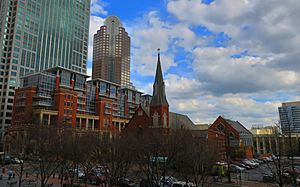
Charlotte has the biggest Jewish community in the Carolinas. Shalom Park is a center for the Jewish community, with synagogues and a community center.
Many African Americans in Charlotte are Baptists or Methodists. There are also many other Christian groups. Besides Christianity, Judaism is the second largest religion, followed by Eastern religions and Islam.
Charlotte's Economy: A City of Business

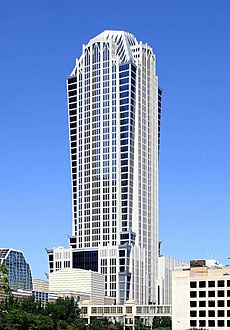
Charlotte is a very important city for banking in the United States, second only to New York City.
Many big banks have their main offices or major operations here, including Bank of America and Truist Financial. Other large companies like Honeywell and Lowe's also have their headquarters or important offices in Charlotte.
Charlotte is also a major center for the motorsports industry. About 75% of the NASCAR racing teams, employees, and drivers are based nearby. You can visit the NASCAR Hall of Fame here.
The city is also becoming known as "Charlotte USA – The New Energy Capital" because many companies focused on energy are located here. The University of North Carolina at Charlotte also has special programs for energy education.
Charlotte is growing fast as a hub for trucking and freight transportation on the East Coast. This is because it's located near major highways and is within a day's drive of many people in the U.S.
In recent years, Charlotte has seen a lot of new buildings go up, especially in Uptown. Many new homes, restaurants, and shops are being built. In 2013, Forbes magazine called Charlotte one of the "Best Places for Business and Careers."
| # | Name | Industry | Number of employees |
|---|---|---|---|
| 1 | Atrium Health | Health Care and Social Assistance | 35,700 |
| 2 | Wells Fargo | Finance and Insurance | 24,000 |
| 3 | Charlotte-Mecklenburg Schools | Educational Services | 18,495 |
| 4 | Wal-Mart | Retail Trade | 17,100 |
| 5 | Bank of America | Finance and Insurance | 15,000 |
| 6 | Novant Health | Health Care | 11,698 |
| 7 | American Airlines | Transportation | 11,000 |
| 8 | Food Lion | Retail Trade | 7,900 |
| 9 | Harris Teeter | Retail Trade | 8,239 |
| 10 | Duke Energy | Utilities | 7,900 |
| 11 | Lowe's | Retail Trade | 7,801 |
| 12 | North Carolina State Government | Public Administration | 7,600 |
| 13 | Daimler Trucks North America | Manufacturing | 6,800 |
| 14 | City of Charlotte | Public Administration | 6,800 |
| 15 | Mecklenburg County | Public Administration | 5,512 |
| 16 | Union County Public Schools | Educational Services | 5,427 |
| 17 | US Government | Public Administration | 5,300 |
| 18 | YMCA of Greater Charlotte | Arts, Entertainment and Recreation | 4,436 |
| 19 | Adecco Staffing, USA | Administration and Support Services | 4,200 |
| 20 | Carowinds | Arts, Entertainment and Recreation | 4,100 |
Fun Things to Do in Charlotte
Museums to Explore
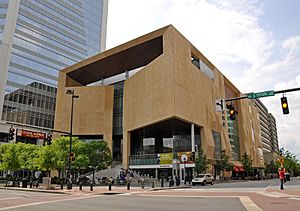
Charlotte has many museums where you can learn and have fun:
- Bechtler Museum of Modern Art
- Billy Graham Library
- Charlotte Museum of History
- Discovery Place (a science museum)
- Charlotte Nature Museum in Freedom Park
- Harvey B. Gantt Center for African-American Arts + Culture
- Levine Museum of the New South
- Mint Museum
- Museum of Illusions Charlotte
- NASCAR Hall of Fame
- Sullenberger Aviation Museum
Performing Arts and Shows
Charlotte offers many live performances:
- Blumenthal Performing Arts Center
- Charlotte Ballet (dance performances)
- Charlotte Symphony Orchestra (music concerts)
- Children's Theatre of Charlotte (plays for kids)
- Opera Carolina (opera shows)
- PNC Music Pavilion (concerts by famous artists)
Festivals and Events All Year Round
Charlotte hosts many exciting festivals and events:
- Carolina Renaissance Festival: This festival takes you back to medieval times with shows, crafts, and jousting. It happens every October and November.
- Yiasou Greek Festival: A big cultural event with Greek food, music, dancing, and art.
- Taste of Charlotte: A three-day festival where you can try food from many local restaurants.
- Moo and Brew Fest: A festival in April with craft beer, burgers, and live music.
- Breakaway Music Festival: Features hip hop and electronic music artists.
- Heroes Convention: An annual comic book convention held in June.
- Charlotte Pride: An annual event in August celebrating the LGBT community.
- Charlotte Turkey Trot: A running marathon held every Thanksgiving.
You can also visit the Charlotte Regional Farmers Market to buy fresh produce from local farmers.
Zoos and Aquariums Near Charlotte
Charlotte is one of the largest cities in the U.S. without its own zoo. However, there are plans for a new Charlotte Zoo in the future.
You can visit the Sea Life Charlotte-Concord Aquarium in nearby Concord. It's a 30,000-square-foot aquarium located inside the Concord Mills mall.
Libraries for Learning and Fun
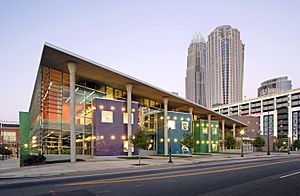
The Charlotte Mecklenburg Library system has over 1.5 million books, CDs, and DVDs. It has 15 locations in Charlotte and branches in nearby towns. All libraries offer free internet and Wi-Fi.
The first public library in Charlotte, the Carnegie Library, opened in 1903. An important library for African Americans, the Brevard Street Library for Negroes, opened in 1905. It was the first of its kind in North Carolina.
Sports in Charlotte
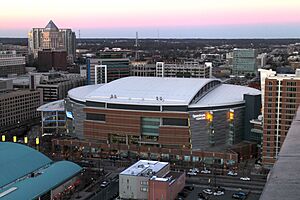
Charlotte is a big sports city! It's home to three major professional teams:
- The Carolina Panthers (football)
- The Charlotte Hornets (basketball)
- Charlotte FC (soccer)
The Panthers and Charlotte FC play at Bank of America Stadium. The Hornets play at the Spectrum Center. The Panthers have won division titles and reached the Super Bowl twice. The Hornets team started in 1988, moved away for a few years, and then came back to Charlotte.
Charlotte also has other professional sports teams:
- The Charlotte Checkers (ice hockey)
- The Charlotte Knights (baseball), who are connected to the Chicago White Sox.
- The Charlotte Independence (soccer)
| Club | Sport | Founded | League | Venue |
|---|---|---|---|---|
| Carolina Panthers | Football | 1995 | National Football League | Bank of America Stadium |
| Charlotte Hornets | Basketball | 1988 | National Basketball Association | Spectrum Center |
| Charlotte FC | Soccer | 2022 | Major League Soccer | Bank of America Stadium |
| Charlotte Checkers | Ice hockey | 2010 | American Hockey League | Bojangles Coliseum |
| Charlotte Knights | Baseball | 1976 | International League | Truist Field |
| Charlotte Independence | Soccer | 2015 | USL League One | American Legion Memorial Stadium |
| Charlotte Eagles | Soccer | 1991 | USL League Two | Sportsplex at Matthews |
| Charlotte Lady Eagles | Soccer | 2000 | W-League | Sportsplex at Matthews |
| Carolina Ascent FC | Soccer | 2023 | USL Super League | American Legion Memorial Stadium |
Charlotte also hosts many big sports events, like the NBA All-Star Game and college championship games.
Learning in Charlotte
Charlotte's School System
The public school system in Charlotte is called Charlotte-Mecklenburg Schools. It's the second largest in North Carolina. About 144,000 students attend 164 schools, from elementary to high school. There are also many private schools in the city.
Colleges and Universities
Charlotte is home to several colleges and universities:
- Central Piedmont Community College
- Johnson C. Smith University
- Johnson & Wales University
- Queens University of Charlotte
- University of North Carolina at Charlotte (UNC Charlotte)
UNC Charlotte is the biggest university in the city, with over 30,000 students. It's located in University City. Central Piedmont Community College is the largest community college in the Carolinas.
Other colleges are located in nearby towns, like Davidson College in Davidson and Belmont Abbey College in Belmont.
Charlotte's Media Scene
Newspapers, Radio, and TV
Charlotte has one main daily newspaper, The Charlotte Observer, which is the largest in North and South Carolina.
For radio, Charlotte is a big market with many stations. You can find local news and music from various groups.
Charlotte is also a large television market. Major TV stations include WBTV (CBS), WSOC-TV (ABC), WCNC-TV (NBC), and WCCB (CW). There's also the ESPN-controlled SEC Network for sports.
Getting Around Charlotte
City Services for Everyone
Charlotte has good city services to help its residents.
- Emergency Medical Services: Mecklenburg EMS Agency (MEDIC) provides emergency medical help. They respond to over 160,000 calls each year.
- Hospitals: Charlotte has several hospitals, including Carolinas Medical Center and Novant Health Presbyterian Medical Center.
- Fire Department: The Charlotte Fire Department has over 1,100 firefighters and 43 fire stations. They respond to fires, medical emergencies, and other dangerous situations.
- Waste Treatment: Charlotte has a system for trash pickup and water treatment.
How People Travel in Charlotte
The Charlotte Area Transit System (CATS) helps people get around the city. It includes:
- Light Rail: The LYNX Blue Line is a train that runs north and south through the city.
- Streetcar: The CityLYNX Gold Line streetcar is being expanded to connect more neighborhoods.
- Buses: CATS has a large bus network with a main hub in Uptown.
Charlotte is also easy to get around by car. Two major interstate highways, I-85 and I-77, cross near the city center. The I-485 beltway goes around the city, making it easier to travel.
Flying In and Out
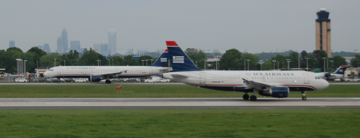
Charlotte Douglas International Airport is one of the busiest airports in the world. In 2019, over 50 million travelers used it. It's a major hub for American Airlines, with flights to many places in the U.S. and other countries.
Trains and Buses Between Cities
Charlotte has an Amtrak station with daily train routes connecting to cities like New York, Atlanta, and New Orleans. You can also travel by bus with Greyhound and Megabus.
The city is planning a new station called Gateway Station that will bring together Amtrak, Greyhound, and future train lines.
Famous People from Charlotte
Many interesting people have come from Charlotte!
Charlotte's Sister Cities
Charlotte has "sister cities" around the world. These are cities that partner with Charlotte to share culture and ideas:
 Arequipa, Peru (since 1962)
Arequipa, Peru (since 1962) Krefeld, Germany (since 1985)
Krefeld, Germany (since 1985) Baoding, China (since 1987)
Baoding, China (since 1987) Limoges, France (since 1992)
Limoges, France (since 1992) Wrocław, Poland (since 1993)
Wrocław, Poland (since 1993) Kumasi, Ghana (since 1995)
Kumasi, Ghana (since 1995)
See also
 In Spanish: Charlotte para niños
In Spanish: Charlotte para niños


